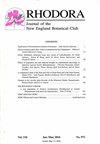Korean Mountain Ash (Sorbus alnifolia, Rosaceae) on Great Blue Hill in Canton, Massachusetts
IF 0.2
4区 生物学
Q4 PLANT SCIENCES
引用次数: 0
Abstract
In 2011 while walking to the top of Great Blue Hill in Canton, Massachusetts, the first author found a small tree approximately 2–3 m tall. The leaves of the tree were alternate with doubly serrate margins, somewhat reminiscent of beech or birch but not matching either genus. The bark of the tree displayed prominent lenticels. The tree could not be identified using any of the floras of the region. While conducting research in Harvard’s Arnold Arboretum, the first author noticed that the tree on Great Blue Hill morphologically matched planted specimens of Sorbus alnifolia (Siebold & Zucc.) K. Koch and also fit the description of the species in Dirr (2009). Eight years later, on November 1, 2019, the Great Blue Hill site was revisited, the tree was found still extant and healthy, a specimen was collected, and a twig was brought to the second author, who confirmed the identification. The S. alnifolia occurs on the path from the Blue Hills Trailside Museum to the summit of Great Blue Hill and the Eliot Tower at approximately 4281301.82 00 N, 7180657.85 00 W. The location of this plant seems entirely natural and the S. alnifolia did not appear planted. The Korean mountain ash co-occurs with Pinus strobus L., Vaccinium angustifolium Ait., Acer rubrum L., Comptonia peregrina (L.) Coult., and Betula lenta L. This collection of Sorbus alnifolia is the first record of the tree in Norfolk Co., Massachusetts, and the only occurrence in North America known outside of Boston, Suffolk Co., Massachusetts, in the wild (Cullina et al. 2011). USDA, NRCS (2019) and other continent-wide references do not report the species as naturalized.马萨诸塞州坎顿市大蓝山上的朝鲜山灰(山梨属,蔷薇科)
2011年,在马萨诸塞州坎顿的蓝山山顶上,第一作者发现了一棵大约2-3米高的小树。树的叶子是交替的,有双重锯齿的边缘,有点让人想起山毛榉或桦树,但不匹配任何属。这棵树的树皮上有突出的皮孔。这棵树无法用该地区的任何植物区系来辨认。在哈佛大学阿诺德植物园进行研究时,第一作者注意到大蓝山上的树在形态上与种植的Sorbus alnifolia (Siebold & Zucc)标本相匹配。K. Koch,也符合Dirr(2009)对该物种的描述。8年后,也就是2019年11月1日,人们重新参观了大蓝山遗址,发现这棵树仍然存在且健康,收集了一个标本,并给第二作者带来了一根树枝,后者证实了这一身份。在从蓝山小道博物馆到蓝山山顶和艾略特塔的路上,大约在北纬4281301.82万,西经7180657.85万。这种植物的生长位置似乎完全是自然的,而且它似乎并没有被种植。韩国山灰与松(Pinus strobus L.)、松(vacinium angustifolium Ait)共生。,红槭,水仙(L.)Coult。该系列是麻萨诸塞州诺福克郡的第一次记录,也是除麻萨诸塞州萨福克郡波士顿以外的北美地区已知的唯一野外记录(Cullina et al. 2011)。USDA、NRCS(2019)和其他全大陆范围的参考文献均未报告该物种已归化。
本文章由计算机程序翻译,如有差异,请以英文原文为准。
求助全文
约1分钟内获得全文
求助全文
来源期刊

Rhodora
生物-植物科学
CiteScore
0.40
自引率
0.00%
发文量
40
审稿时长
>12 weeks
期刊介绍:
This peer-reviewed journal is devoted primarily to the botany of North America and accepts scientific papers and notes relating to the systematics, floristics, ecology, paleobotany, or conservation biology of this or floristically related regions.
 求助内容:
求助内容: 应助结果提醒方式:
应助结果提醒方式:


